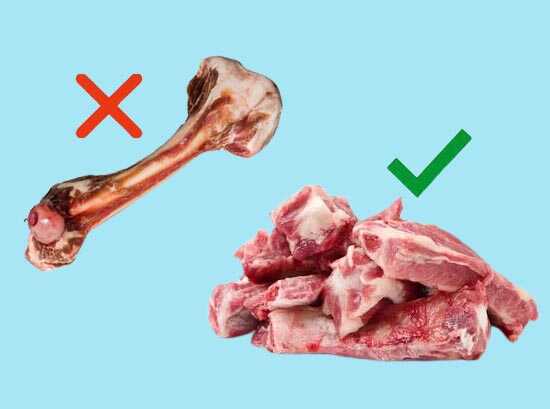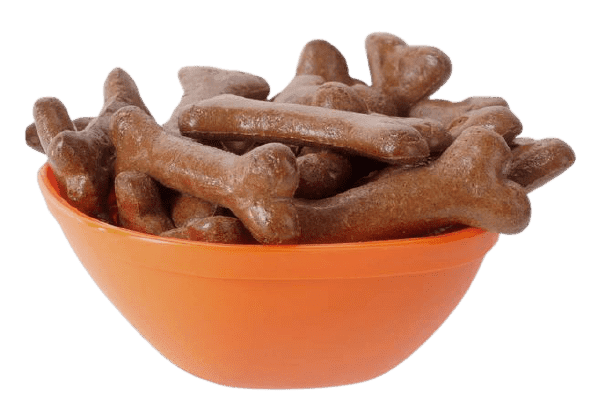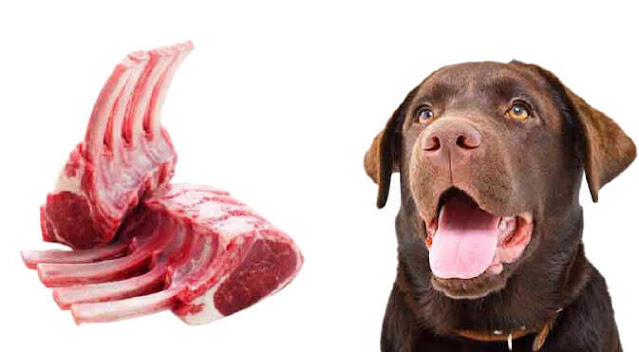The thing about bones and dogs is popular lore as deep-rooted as children's stories, although with a difference, this was not invented by us.
It turns out that dogs have ALWAYS been fed on bones since man is man and dog is dog :-)

And yet there is a kind of taboo about giving bones to our dogs...
Even when in any food store we can buy hundreds of bone-shaped gadgets that have nothing to do with the original.
Some diets are recovering their use. If you've heard of the BARF diet, you already know that giving bones is a common practice.
But it is one of the thorniest issues and one that most heats the debate among consumers, nutritionists and veterinarians.
What is the reason? There is a lot of ignorance when it comes to adding bones to the diet of our companions and even fear due to the voices that point to the danger they can pose.
The truth? When you give the right ones and in the right way, bones have a multitude of benefits for your dog (also cats) and any risk is greatly reduced.
It is indeed important that for our pets to have a food chart that contains almost all the nutrients. Bones are important as food. It is very typical for you to think about these things that why raw bones are great for dogs and cats! or what should I feed my cat? or even which raw bone for your dog and cats can be fitted in diet? and much more...
We explain it step by step ... but first...
When it is NOT Advisable to Give Bones to Your Dog
We go with the exceptions to ensure that everything is understood.
If you are consuming well-balanced menus with the bone already minced, you do not need to add more bone to feed it.
If your dog eats feed it is not recommended either because to digest the bones they need a certain stomach pH or and pancreatic enzymes that they do not usually have when they eat feed.
In fact, even starting the barf diet, you would have to wait 4-6 weeks before giving the first edible bone.
If your dog does not feel good bones. It does not digest them well; it is difficult to eat them or other reasons.
If your dog has a disease that advises against it, such as pancreatitis. When in doubt, it is always better to ask a qualified veterinarian.
If you are not in any of these situations, we will continue to tell you :-)
Are Bones Dangerous for Your Dog or Cat?
Yes, if we give them incorrectly and / or irresponsibly.
No, if we give them the correct ones and teach our little ones to eat them.
Why do it then?
Because the benefits are very interesting:
✅ They are very nutritious (minerals and other nutrients)
✅ Helps keep teeth clean and strong
✅ It relaxes them...
✅ It can save your sofa and furniture!

How Should Safely Give Your Dog Bones?
We're glad you asked us that question ... :-)
✔ The bones that we give them to eat must be RAW.
Cooked bones break in different ways because they have lost their elasticity in the cooking process and can present splinters that can pose a risk to our dog or cat.
✔ If it is to be eaten, they must contain meat around it, that is, it must be a Fleshly BONE.
A meaty bone is usually half its weight in meat and half in bone. A good example is a chicken carcass or wing.
✔ You have to choose the RIGHT SIZE for your dog. Mainly, to ensure that it is not easy for you to swallow it whole.
As a safety rule, do not give him a bone that is smaller than his head and, in any case, watch him throughout the process until he eats it in its entirety.
✔ If you are not used to eating raw bones, we should TEACH YOU.
We will try not to give it to him on an empty stomach, as the craving could encourage him to swallow it too soon.
At first, it is good to give it after eating and hold it by one end while it begins to gnaw and break into small pieces.
We will congratulate you when you do well and remove it when there is the last small piece left that you could swallow in one bite.
✔ Puppies can start eating soft bones as soon as their baby teeth develop.
This can happen at 12 weeks and with them they can already chop and chew. It will be important to choose the right bones for this age.
What Types of Bones can You Give Your Dog?
You can give your dog bones from almost any animal.
But with chicken, turkey, lamb and beef we should have more than enough for a healthy and balanced diet.
No need to look for rare meat bones :-)
We usually talk about EDIBLE BONES and RECREATIONAL BONES.
EDIBLE BONES
Edible bones, among which are fleshy bones, provide high nutritional value.
They are soft, flexible, contain no pith and can be easily crushed.
Good edible bones for large dogs are:
👉 Turkey Necks
👉 Whole Lamb or Veal Necks
👉 Chicken or Turkey Carcasses
👉 Lamb or Beef Skirt
👉 Beef scapula (almost all cartilage ... in fact cannot be considered a source of calcium)
Good edible bones for small dogs are:
👉 Chicken Necks
👉 Chicken Carcasses
👉 Chicken Wings
Paws are best avoided as they are harder and, despite being raw, they could break badly or be a challenge for teeth - when in doubt, better reduce any risk. If you decide to give it to them, better bird.
For example, if your dog is not an expert and is very used to it, you will avoid chicken or turkey thighs or beef ribs.
RECREATIONAL BONES
Recreational bones are more for entertaining, providing long hours of chewing fun :-)
In addition, they are a perfect ally to massage the gums and remove tartar.
It is better to choose flat bones versus round and long bones.
Thus, you reduce the risk of ingestion, since the ends of the seconds can be easily detached, or damage to the teeth, since the long ones, being structural, tend to be harder.
Also, flat bones are more entertaining because they have recesses where the meat stays.
Good recreational bone options for large dogs are:
👌 Cow Knee Bones
👌 Cow Femur
👌 Cow Hip
👌 Also lamb heads or other animals if you can get them
Good recreational bone options for small dogs are:
💢 Scapula (as long as, due to the size of the dog, they cannot be swallowed)
💢 Beef Brisket
💢 Cow Rib
💢 Turkey Necks
There are other options, although some are not bones per se and do not provide as many nutrients:
* Veal trachea (not the one we like the most because they can swallow it and get stuck)
* Cow or Bull Ligaments
* Deer horn (although, again, if your dog is very anxious, it is better to avoid them because they are very hard)
The effect of recreational bones in reducing dental stones has been studied in Beagles (F R Marx 2016). The results showed reductions of 30% to 80% of the total dental calculus.
What Nutrients Do Bones Provide to Your Dog?
Here it is important to understand what the components of bones are.
Recreational bones often contain Marrow, or marrow in colloquial language.
Marrow is not bone per se, it is primarily fat and blood components - it is in fact where blood cells are produced - which are rich in nutrients.

It also contains 7% protein (Loren Cordaina, Bruce A. Watkins, 2001).
Bones in general have Cartilage, which is 50% connective tissue composed of collagen - containing two important amino acids such as proline and glycine - and mucopolysaccharides - long glucose molecules combined with mucus.
It must be said that the digestibility of collagen by our dog may not be total, although it has not been studied in depth yet (S. Hooda and L. G. Ferreira, 2015).
So far the organic components, which represent 1/3 of the content. The remaining 2/3, the bone itself, is mainly Calcium Phosphate.
The ratio of calcium and phosphorus is optimal because it’s ratio in the bone of 2.5: 1, always with more presence of calcium and influences the amounts to be given.
In addition to calcium and phosphorus, they are also rich in sodium, iron, magnesium, and zinc.
In the case of edible bones, it is also necessary to count among the nutrients those of the meat, in the form of proteins and fats, etc. but we have already covered this extensively before.
How Many Bones Should Give Your Dog?
To this question, depending on the school, you can find many answers.
First of all you should know that if you already give a complete menu, it must already have the crushed bone included. In this case, you do not need to give him bone for food but, perhaps only recreational.
If you prepare their food yourself. Our recommendation is to give them between 10% and 20% of their food in the form of raw meaty bone and never more than 25%.
The idea is that you do not reduce the intake of other types of nutrients and avoid constipation.
If for some reason we cannot give our dog meaty bones, take a look at the last part of this post to see alternatives.
Regarding the frequency, our experience is that this can be daily, in one or different meals, both mixed with your usual food or separately.
If you stay at these percentages and frequency, you will ensure that everything is going well, and if you also add variety, much better.
What are The Benefits of Giving Raw Bones?
In general, all owners experience that their dogs or cats defecate harder.
This is normal since the bone acts as an astringent; if it is too much, try to reduce the amount.
The side effect of this is that the contents of the anal sac are released naturally. Without having to go to the vet to empty the anal glands for this reason, this is expensive.
A whiter color is also perceived in the stool.
When it comes to teeth, we have seen few dogs or cats eating meaty bones that have signs of gingivitis or tartar on the gums.
And if we look at the psychological aspect, there is no doubt that having our friend gnaw for hours is something that helps us reduce anxiety and have a more balanced dog.
Special Considerations for Cats
Most of the advice that applies to dogs also applies to cats with some differences.
For cats, we recommend:
-Wings
-Chicken, turkey (for the brave) or duck necks
-Pieces of rabbit
Always choose fresh meat since, unlike dogs, cats do not have such a resistant digestive system.
In general, and given their greater self-control over food, they require less supervision, although it is good to keep an eye on it at first.
Cats love to play, so don't be surprised if they throw their wing up in the air and hunt it again to keep eating.
Latest Recommendations
The marrow is nutritious but it is also very caloric (51% fat), so it should not be passed or given to obese dogs
Try to give your dog his bones when he is calm and always place him on a towel in the same place to avoid unwanted stains.
Avoid the presence of other dogs, as the bones accentuate dominance behaviors and even practice giving it and taking it off with your dog so that it respects you.
And finally, if you do not feel encouraged by these tips or your daily routine does not allow it, remember that you can always count on raw commercial menus, which already contain the appropriate amount of crushed bone included in their formulation.
100% Natural Alternatives to Meaty Bones
There are dogs that do not tolerate bones. They make them feel bad, they cause digestive disorders or their teeth hurt.
If your dog is in this situation or you prefer not to give them, here are several alternatives to supplement:
MCH Calcium. It is cold-dried and ground bone, which has all the benefits of bones that we have talked about and can be added to the diet in a normal way.
The eggshell. The shell is not as complete as MCH because it is not bone but provides calcium in the form of calcium carbonate.
Calcium Citrate. It does not contain any phosphorus or other minerals so it is highly recommended for dogs and cats with kidney problems or oxalate stones.
Where to Get Raw Bones for Dogs?
You can get raw meaty bones from dog food retailers in any butcher shop they should be able to provide you, at least the following types, even if it is on request:
** Front or back meaty chicken carcasses
** Calf hip bone
** Rack of lamb or beef brisket
** Chicken or turkey necks
** Which are Lamb or Cow
** Heads
** and others
We need to be aware of our favorite pet's nutrition, health, and what needs to be included in their diet and what foods to feed at what age. Bones are very important in the diet and its benefits are mentioned in this article. There may be two types of bones on the food list, such as, Raw Bone and Cooked Bone. Now the following things must come to your mind like-
What are the benefits of raw bones for dogs/benefits of raw bones for dogs?
What kind of bones is safe for dogs-best raw bones for dogs?
Cooked beef bones for dogs-Can dogs eat cooked beef bones?
What age can you give your puppy a bone?
If you want to read more articles above - you know the answer here; we recommend that you enter our Pets category. We will be bringing you more details on these topics soon. Please bookmark and subscribe to our web page and keep an eye on our web page.
You May like : Super Nutritional Power for Your Pets













0 Comments